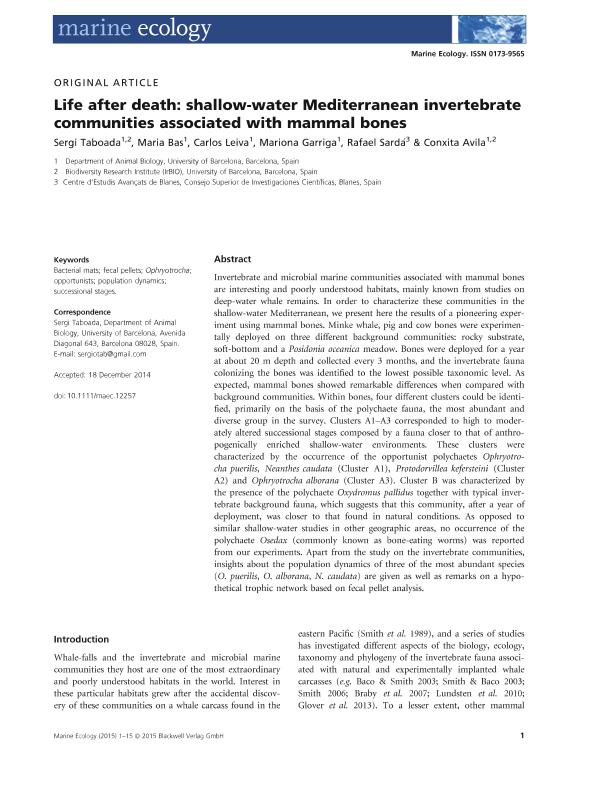Artículo
Life after death: Shallow-water Mediterranean invertebrate communities associated with mammal bones
Fecha de publicación:
02/2016
Editorial:
Wiley Blackwell Publishing, Inc
Revista:
Marine Ecology-pubblicazioni Della Stazione Zoologica Di Napoli I
ISSN:
0173-9565
Idioma:
Inglés
Tipo de recurso:
Artículo publicado
Clasificación temática:
Resumen
Invertebrate and microbial marine communities associated with mammal bones are interesting and poorly understood habitats, mainly known from studies on deep-water whale remains. In order to characterize these communities in the shallow-water Mediterranean, we present here the results of a pioneering experiment using mammal bones. Minke whale, pig and cow bones were experimentally deployed on three different background communities: rocky substrate, soft-bottom and a Posidonia oceanica meadow. Bones were deployed for a year at about 20 m depth and collected every 3 months, and the invertebrate fauna colonizing the bones was identified to the lowest possible taxonomic level. As expected, mammal bones showed remarkable differences when compared with background communities. Within bones, four different clusters could be identified, primarily on the basis of the polychaete fauna, the most abundant and diverse group in the survey. Clusters A1-A3 corresponded to high to moderately altered successional stages composed by a fauna closer to that of anthropogenically enriched shallow-water environments. These clusters were characterized by the occurrence of the opportunist polychaetes Ophryotrocha puerilis, Neanthes caudata (Cluster A1), Protodorvillea kefersteini (Cluster A2) and Ophryotrocha alborana (Cluster A3). Cluster B was characterized by the presence of the polychaete Oxydromus pallidus together with typical invertebrate background fauna, which suggests that this community, after a year of deployment, was closer to that found in natural conditions. As opposed to similar shallow-water studies in other geographic areas, no occurrence of the polychaete Osedax (commonly known as bone-eating worms) was reported from our experiments. Apart from the study on the invertebrate communities, insights about the population dynamics of three of the most abundant species (O. puerilis, O. alborana, N. caudata) are given as well as remarks on a hypothetical trophic network based on fecal pellet analysis.
Archivos asociados
Licencia
Identificadores
Colecciones
Articulos(CADIC)
Articulos de CENTRO AUSTRAL DE INVESTIGACIONES CIENTIFICAS
Articulos de CENTRO AUSTRAL DE INVESTIGACIONES CIENTIFICAS
Citación
Taboada, Sergi; Bas López, Maria; Leiva, Carlos; Garriga, Mariona; Sardá, Rafael; et al.; Life after death: Shallow-water Mediterranean invertebrate communities associated with mammal bones; Wiley Blackwell Publishing, Inc; Marine Ecology-pubblicazioni Della Stazione Zoologica Di Napoli I; 37; 1; 2-2016; 164-178
Compartir
Altmétricas




